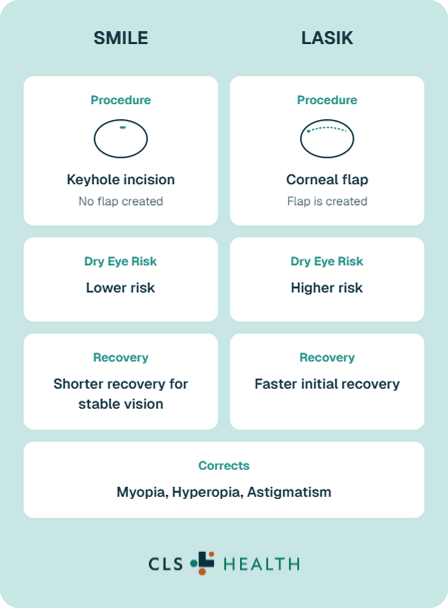If you’re exploring laser vision correction, SMILE (Small Incision Lenticule Extraction) is one of the most advanced options available. Unlike LASIK or PRK, SMILE is a flap-free, minimally invasive procedure that reshapes the cornea through a tiny incision.
For many patients, it offers clear vision with a smaller incision and no flap-related risks. Early recovery is typically comparable to—or slightly slower than—LASIK, and dry-eye symptoms may be reduced for some patients.
In this guide, we’ll explain how SMILE works, what recovery looks like, potential side effects, and how it compares with LASIK—so you can decide which treatment best fits your vision goals.
What Is SMILE Eye Surgery?
SMILE is a next-generation refractive surgery that corrects nearsightedness (myopia) and astigmatism using a femtosecond laser. Rather than creating a corneal flap, the laser makes a small, disc-shaped piece of tissue called a lenticule inside the cornea, which is then removed through a micro-incision about 2–4 mm wide.
This gentle technique preserves more of the corneal structure, reducing the risk of flap-related complications and potentially minimizing dry-eye symptoms after surgery. Patients often choose SMILE for its precision, safety, and flap-free recovery experience.
The SMILE Eye Surgery Procedure
SMILE is an outpatient procedure that typically takes 10–15 minutes per eye.
- Preparation: Numbing drops are applied, and you’re positioned under the femtosecond laser.
- Lenticule Creation: The laser forms a small lenticule inside the cornea.
- Removal: The surgeon removes the lenticule through a micro-incision, reshaping the cornea.
- Completion: No flap or stitches are needed. The incision heals naturally within a few days.
Most patients return home the same day and notice visual improvement within the first 24–48 hours.
SMILE Eye Surgery Recovery Time
Recovery from SMILE is typically smooth and comfortable. Vision often improves within a couple of days, though it can take several weeks to stabilize completely.
- First 24–48 hours: Mild dryness or light sensitivity is common. These early symptoms are temporary and part of the normal healing process.
- 1 week: Most patients can return to work and daily activities.
- 2 weeks: Exercise and sports are usually safe to resume.
- 1–3 months: Vision fully stabilizes with long-term clarity.
Most patients can drive within a few days, once their vision meets legal standards and the surgeon gives clearance.
How Long Does SMILE Last?
Results from SMILE are long-lasting and considered permanent. The reshaped cornea doesn’t revert to its original state, though natural age-related changes such as presbyopia or cataracts can still affect vision later in life.
For most patients, SMILE provides decades of clear vision with little to no dependence on glasses or contact lenses.
SMILE Eye Surgery Side Effects & Risks
SMILE is a safe and effective procedure with a strong clinical track record. Still, minor side effects can occur:
- Temporary: Mild dryness, glare, or halos around lights during recovery.
- Rare risks: Overcorrection, undercorrection, infection, transient light sensitivity syndrome (TLSS), or—very rarely—corneal ectasia.
Compared with LASIK, SMILE tends to cause less dry eye and avoids flap-related issues, making it a good choice for active individuals or those at risk of flap trauma.
Your surgeon will discuss these risks during your consultation or eye exam and determine whether SMILE is the right option for your eyes.
SMILE Eye Surgery vs. LASIK: Which Is Better?
Both SMILE and LASIK correct nearsightedness and astigmatism, offering clear, lasting vision. The main differences come down to surgical technique, recovery speed, and dry-eye risk.
The comparison chart below highlights how each procedure works and who may benefit most:

Your ophthalmologist will help determine which option is best for your eye health, prescription, and lifestyle.
Cost of SMILE Eye Surgery
The cost of SMILE surgery typically falls within the same range as LASIK or PRK—usually several thousand dollars per eye, depending on your surgeon, technology, and individual treatment needs.
In Houston, pricing aligns with national averages. Most insurance plans do not cover elective vision correction, though financing and payment plans are often available.
Why Choose CLS Health for SMILE Eye Surgery
At CLS Health, our board-certified ophthalmologists specialize in advanced laser vision correction techniques—including SMILE, LASIK, and PRK. We use state-of-the-art femtosecond laser technology to deliver precise, personalized results.
With locations convenient to Houston and Clear Lake, our team provides comprehensive care—from your first evaluation through post-surgery follow-ups—to ensure optimal outcomes and comfort every step of the way.
Schedule a SMILE Eye Surgery Consultation in Houston
SMILE eye surgery offers a safe, flap-free alternative to LASIK with faster healing and reduced dry-eye concerns. If you’re ready to explore vision correction options, our ophthalmologists can help determine whether SMILE is right for you.
Schedule your consultation today with a CLS Health eye specialist in Houston–Clear Lake and take the next step toward sharper, clearer vision.
FAQs
No. Numbing drops keep you comfortable, though mild irritation or light sensitivity can occur for a few days afterward.
Most patients can drive within a few days once vision is stable and meets safety standards.
Yes. SMILE is FDA-approved to correct myopia (up to about –10.00 diopters) and certain degrees of astigmatism (up to about 3.00 diopters), depending on corneal health.
Vision typically improves within 24–48 hours, with full clarity developing over several weeks.
Enhancement procedures are possible if vision changes or additional correction is needed later in life.
